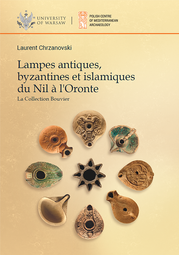Informacje o publikacji
O publikacji
Fragmenty
Dodatki
Dodatki
Recenzje
Bibliografia
Zobacz również
O publikacji
| Wydanie: | 1 |
| Miejsce i rok wydania: | Warszawa 2019 |
| Język publikacji: | angielski |
| ISBN/ISSN: | 978-83-235-4098-4 |
| EAN: | 9788323540984 |
| Liczba stron: | 474 |
| Wielkość pliku: | 34,57 MB |
| Typ publikacji: | Praca naukowa |
| DOI: | https://doi.org/10.31338/uw.9788323540984 |
Przedstawione w publikacji wyniki badań archeologicznych w jednej z dzielnic mieszkalnych na stanowisku Tell Arbid dostarczyły nowych danych na temat jednego z kluczowych momentów w rozwoju Syryjskiej Dżeziry (EJZ2–EJZ3, 2550–2350 p.n.e.) – okresu transformacji społeczno-gospodarczych a jednocześnie okresu najbardziej dynamicznego w rozwoju samego stanowiska. Rezultaty badań pozwoliły na lepsze poznanie jak funkcjonował dom i gospodarstwo domowe w średniej wielkości mieście z punktu widzenia kultury materialnej, organizacji społecznej, zasobów gospodarczych czy życia codziennego mieszkańców.
******
The exploration of house and household–architecture, domestic features and artifacts–from a major site in the Syrian Jezirah at a key period in the development of the region (EJZ2–EJZ3, that is, 2550–2350 p.n.e.) has given a vivid picture of the life of an ancient community, its material culture, social organization, economic resources and daily activities at the time of its greatest development. Tell Arbid in northeastern Syria was a middle-sized town whose rise and expansion was particularly dynamic in the Ninevite V period (EJZ1–EJZ2), reflecting the robust urbanization processes that were part of a widespread socio-economic transformation of the region at the time.
A study of the results of more than 10 years of archaeological investigation of Area D on Tell Arbid, focusing on the sphere of community life in one of the urban districts recognized in the town, has given new insight into the way of life of the inhabitants and the functioning of the house as an economic unit, as well as the nature of food preparation and home industries, recognizing in greater depth the social and economic structure of the community that once inhabited this town.

Zobacz inne publikacje z serii: PAM Monograph Series »
******
The exploration of house and household–architecture, domestic features and artifacts–from a major site in the Syrian Jezirah at a key period in the development of the region (EJZ2–EJZ3, that is, 2550–2350 p.n.e.) has given a vivid picture of the life of an ancient community, its material culture, social organization, economic resources and daily activities at the time of its greatest development. Tell Arbid in northeastern Syria was a middle-sized town whose rise and expansion was particularly dynamic in the Ninevite V period (EJZ1–EJZ2), reflecting the robust urbanization processes that were part of a widespread socio-economic transformation of the region at the time.
A study of the results of more than 10 years of archaeological investigation of Area D on Tell Arbid, focusing on the sphere of community life in one of the urban districts recognized in the town, has given new insight into the way of life of the inhabitants and the functioning of the house as an economic unit, as well as the nature of food preparation and home industries, recognizing in greater depth the social and economic structure of the community that once inhabited this town.

Zobacz inne publikacje z serii: PAM Monograph Series »
O autorze
Recenzje
Bibliografia
Fragmenty
Dodatki
Dodatki
Zobacz również


























